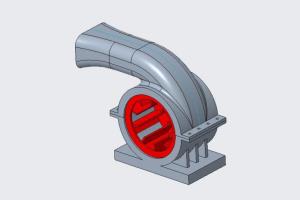

The parametric nature of this method allows models to be easily modified in a predictable, scalable manner. These features are ideal for a user already familiar with other modelling software, as the use of many of the same techniques will have a designer feeling at home.

With parametric surfacing, changes can be made using traditional modelling tools, where sweeps, blends, and extensions are used to acquire precise, tightly defined dimensions. Supporting both parametric and freestyle surfacing, Creo Parametric lets a designer change every curve of a geometry by using either of these intuitive methods. SurfacingĬreo Parametric’s surfacing abilities are some of its most mature. The Creo suite’s emphasis towards real, manufactured products is demonstrated by many of Creo Parametric’s features. Creo Parametric’s “Unite” toolset even features support for importing geometries from competing applications.Ĭreo Parametric also supports 2D drafting in addition to its 3D modelling capabilities, meaning that a designer can easily switch between the 3D model and its corresponding 2D draft, with either view reflecting changes made on the other.
#CREO 3D MODELING FULL#
Its surfacing capabilities allow users to turn their 2D sketches into full 3D models by either parametrically building or organically shaping complex surfaces. Creo ParametricĪs the main hub for all Creo software, Creo Parametric is a robust modeling tool whose focus is on providing modularity and instant feedback for design changes. While the Creo suite contains dozens of unique tools, familiarity with just a select few can greatly become a designer or engineer’s best asset. It links these often separated processes by providing fully featured tools as add-ons for their flagship software, Creo Parametric. Included are tools for concept and industrial design, simulation and analysis, and general production readiness.
#CREO 3D MODELING SOFTWARE#
At its core, the Creo software suite from PTC focuses on interconnecting the modeling and prototyping phases of product development.

Creoĭespite this far reach, however, PTC’s primary offering in CAD/CAE – its Creo family of software – is still its most matured and popular product. Both of these separate technologies can then be brought together with the inherent IoT-like structure of the ThingWorx platform, meaning that an interactive AR training program can use the information gathered from the PLM system to properly gauge successful instruction: a true revolution in technology. Windchill, the web-based PLM solution, relies on the modularity of a 3D assembly to easily create and manage variations of a product to suit customer need. PTC’s premiere AR program, ThingWorx Studio, requires fast, accurate 3D representations of an environment in order to correctly augment it. PTC has now diversified itself to the point of being present in many of today’s most innovative areas of technology and research, as shown with its current portfolio here:ĭigital Product Development using AR, PLM, IoTĪlthough founded around CAD/CAE, PTC’s offering has since expanded to include an entire portfolio of digital product development applications. PTC now boasts a product catalog of tremendous breadth with Engineering Math, Product Lifecycle Management (PLM), Internet of Things (IoT), and even Augmented Reality (AR) solutions. PTC’s roots are firmly cemented in the realm of Computer Aided Design/Engineering (CAD/CAE) via it’s Mechanical Design Software called Creo Parametric (originally Pro/Engineer). Creo Parametric: An Overview of PTC’s CAD/CAE Software


 0 kommentar(er)
0 kommentar(er)
